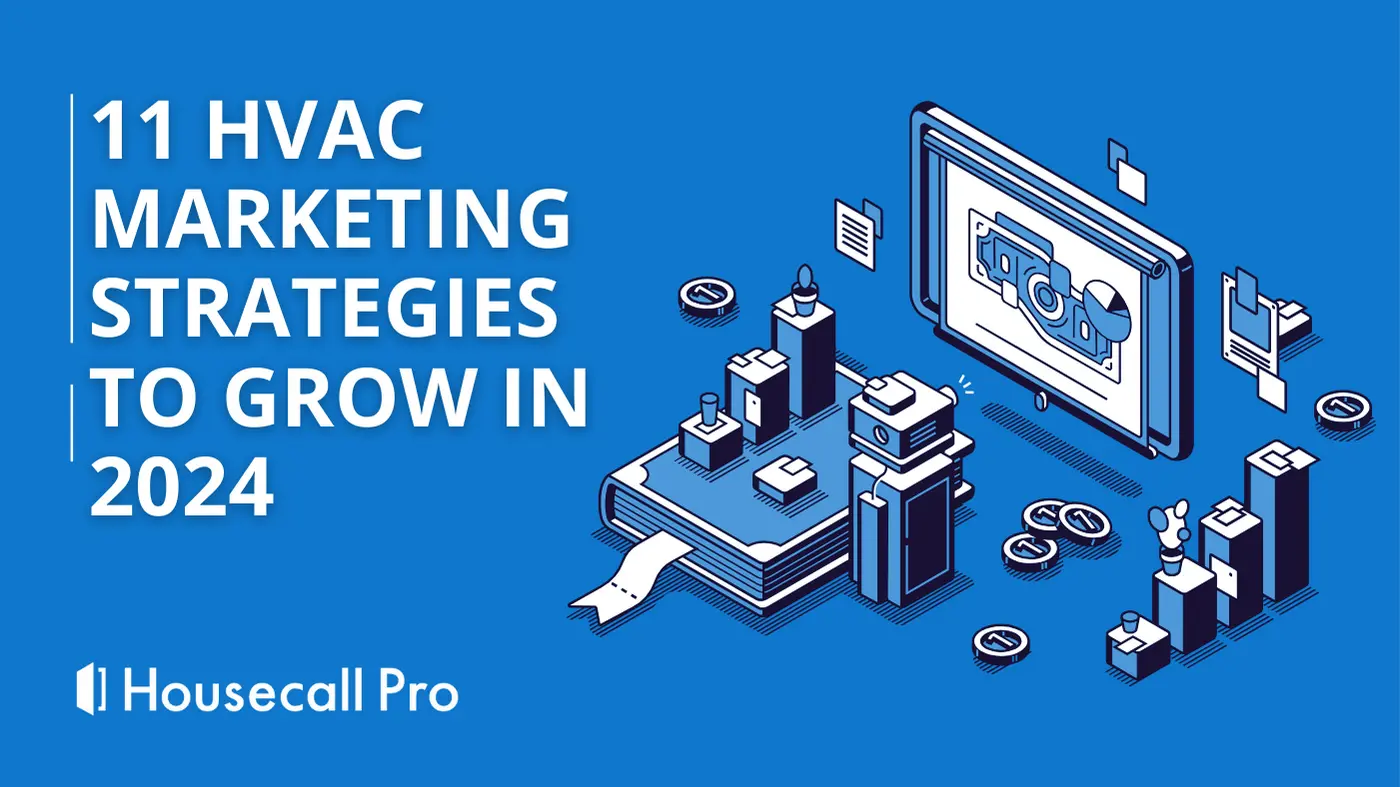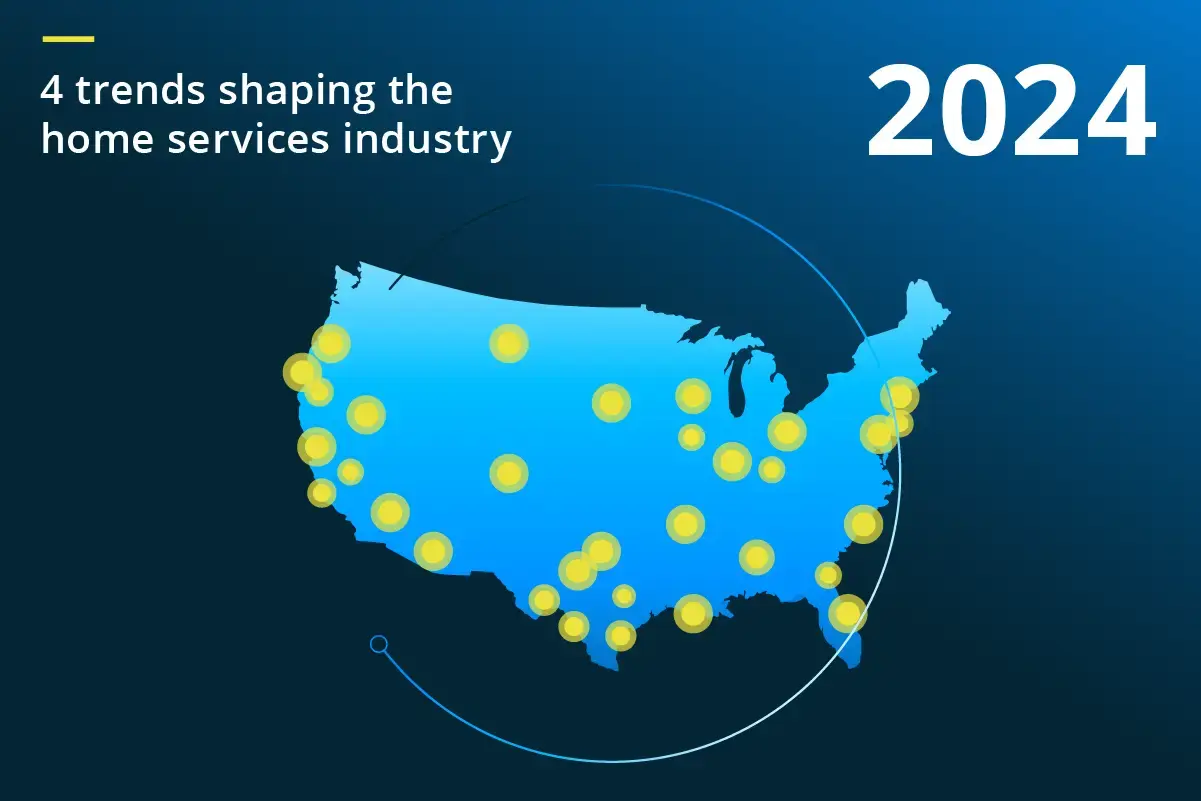
As a small business owner, marketing yourself might seem like a daunting task. That’s why we’ve compiled a list specific to HVAC businesses to help you gain some traction in the world of modern marketing.
Grow your HVAC company with these 11 HVAC marketing strategies
- 1. Create an engaging website
- 2. Optimize your website for SEO
- 3. Use business cards to your advantage
- 4. Ask customers for reviews and testimonials
- 5. Send email marketing campaigns
- 6. Stay away from “aggressive” marketing techniques.
- 7. Monitor and build your Google Business Profile
- 8. Create social media accounts for your business
- 9. Advertise using company vehicles.
- 10. Consider starting a blog
- 11. Conduct your business with honesty and integrity
- Final Thoughts
Let’s get right into it!
1. Create an engaging website
Your website and Google Business Profile are how the majority of your clients will find you. Your Google profile will have a link directly to your company website. Your company website should have your contact information and service area on the front page and be easy for clients to find.
Use large fonts and simple designs that aren’t overwhelming on mobile devices. Your website should be created with a responsive layout in mind. This is a design option you can choose when building your website that will allow it to be readable on both a desktop and a mobile phone.
When building websites, simple is often better. If you want to read a more detailed article about creating and improving your HVAC website, check out “10 Ways to Improve Your HVAC website.”
2. Optimize your website for SEO
SEO, or “search engine optimization” is exactly what it sounds like. This process entails using specific keywords to make your site more “discoverable” by search engines like Google and Bing. Search engines will analyze the text and images on your website and rank your pages according to what they find. This ranking is how your content will show up when someone searches certain keywords. Most people utilizing search engines will click on the first few results that are shown, so HVAC SEO can be pretty important.
Optimizing your site for SEO means that your site will rank higher and show up closer to the top of the search results that customers see.
SEO optimization and tracking can be a bit of an art. The search engine algorithms are constantly changing, so what worked great six months ago might be obsolete today. If you are working to optimize your website for SEO, it is a good idea to talk with a professional with proven success in that area. You can also find online classes to learn about SEO optimization if you want to do it yourself.
That being said, here are a few proven ways to improve your website’s ranking in search engines:
- Include keywords in titles and headings. This is one of the biggest ways that search engines analyze articles and web pages. If you want your content to show up when someone searches “air conditioning repair in Pleasant Valley,” you need to put those keywords in your titles, headings, and URLs.
- Update content often. Search engines rank sites higher if they are regularly updated. This is where it gets useful to have a weekly blog connected to your website where you can add relevant information and HVAC industry news that might be of interest to your clientele.
- Use internal links. Link internally to your own blog posts and relevant web pages. You can also link to outside sources that write authoritative HVAC content. These can be equipment manufacturers, local energy companies that you work with, environmental agencies, or universities that have done HVAC-related studies.
- Design your website with a responsive layout. Websites that can scale to desktop and mobile are ranked higher by search engines. This is an easy way to boost your ranking if you don’t already have a responsive layout.
- Create accurate and engaging content. While you don’t want to go overboard with keywords in your content and risk sounding like an AI bot, you can use a few of the keywords strategically placed throughout. However, at this point, it is more important that you create accurate and informative content for your readers. Avoid showing brand or company bias and allow readers to make informed decisions based on fact.
3. Use business cards to your advantage
Despite the growing reliance on technology in the world of professional marketing, business cards remain a relevant tool to gain new clientele. Keep a stash of business cards in your work truck to hand out to your customers at the end of the job.
You can also leave business cards on public bulletin boards found in local stores, restaurants, and other storefront buildings in the areas you service.
Keep your business cards simple and use a font that is large and easy to read. Include your company name, phone number, and address. If you have a separate number for emergency service, as most HVAC companies do, be sure to include that as well.
4. Ask customers for reviews and testimonials
If you provide good service, most of your clients will be happy to give you a review to grow your HVAC business. Testimonials are a great addition to your website and showcase your honesty and reliability. However, your Google reviews are likely to be the first thing potential new clients will see when they search for your business.
Keep an eye on your Google reviews and/or utilize review management software. Thank customers for reviewing your business and quickly address any negative reviews you find with thoughtful responses.
5. Send email marketing campaigns
Automated marketing is a great way to provide your clients with helpful HVAC tips and reminders, along with showcasing new products or promotions. Be careful not to use too much “sales” talk or your clients will likely send your emails straight to the spam folder. However, these types of emails are useful for informing your customers of busy times and as friendly reminders to schedule annual tune-ups and other preventive services.
Keep these emails short and informative. Don’t make them overwhelming or you will lose engagement from your clients. A short newsletter sent out once per month is more than enough.
6. Stay away from “aggressive” marketing techniques.
Avoid using tactics that annoy potential customers – like making them give you their email address or phone number before showing your prices or product lists. While this might seem like an easy way to compile email addresses for more tailored marketing, the reality is that a large majority of potential clients will click away instead of providing their information. Most people have enough spam emails and robocalls clogging up their communication lines already. You might actually lose business by using these techniques. Generating a profit is important for your business but you don’t want to be too heavy-handed about it.
Get In Touch: 858-842-5746
Let us earn your trust
See plan options and feature breakdown on our pricing page.
7. Monitor and build your Google Business Profile
Your Google Business Profile is one of the first things clients see when they google your name.
Your Google Business Profile shows:
- Your business name
- Phone number
- Emergency number
- Business hours
- Physical address
- Google reviews
- Website link
You want to monitor your Google profile to ensure all information remains accurate. Google is the largest search engine in the world. If customers can’t find you on Google, they likely won’t be able to find you at all.
If the information on your Google profile is incorrect, you can contact Google’s team directly to make any necessary changes.
It is a good idea to keep an eye on your Google reviews as well. If you receive any negative reviews, do your best to find a fair solution for your clients. You can publicly respond to your Google reviews through your business profile. Be sure to thank those who took the time to write you positive reviews.
8. Create social media accounts for your business
If you choose to forgo a company website, consider making a Facebook page for your business instead. You can link this page to your Google profile and use it in place of a website. You can also use your company’s Facebook page to inform customers of news about your business and potential promotions you are offering.
Some companies with a large online presence have YouTube accounts as well where they make videos related to HVAC. These videos can be anything from job studies to answering common questions like “Which kind of filter should I choose?”
If you decide to make YouTube videos, you can use the platform to showcase the kind of equipment you install and how it can benefit your clientele.
9. Advertise using company vehicles.
This is free advertising for your company when you’re out on the road. You want to make sure the name of your business and your phone number are large and easy to read from a distance. It is helpful to have a memorable logo and design on the truck. Many HVAC companies also include the city they are located in as well.
Vehicle advertising is done using vinyl graphics or decals. If you are on a budget, you can get magnets made with your company information that stick to the door of your truck or the side of your van.
10. Consider starting a blog
We talked a little about blogs when considering SEO optimization. Blogs are a good way to keep your search engine ratings up while engaging with your clientele. As mentioned before, don’t just use your blog as a sales platform. While you should occasionally feature your products, make sure you have other engaging content as well. If your clients think you are just pushing sales, they aren’t going to bother reading your blog.
Think of the most common questions you get from customers on the job and start there.
11. Conduct your business with honesty and integrity
When you get a call at 9 PM in the dead of winter from a client whose furnace has gone out, you might consider giving them some things to check before you come out and charge them for a service call. Have they checked the thermostat batteries? Is the filter clean? Is the exhaust blocked outside by ice? Could there be snow in the intake?
If you can help your client fix it over the phone, you will lose out on a service call but you will likely gain a client for life. Homeowners want trustworthy service providers, especially those that have to come into their homes. If your clients believe you are an honest and fair technician, they will refer you to their friends and family. Word-of-mouth marketing is critically important, especially for local service-based HVAC businesses.
Final Thoughts
Creating a strong internet presence is one aspect of marketing your HVAC business, but that isn’t all there is to it. Build your reputation online and in your community through local advertising and customer engagement. The best thing you can do for your growing HVAC business is to provide prompt, correct, and honest work at a reasonable price. If your clients are happy with your work, they will be more likely to refer you to their friends and family.





